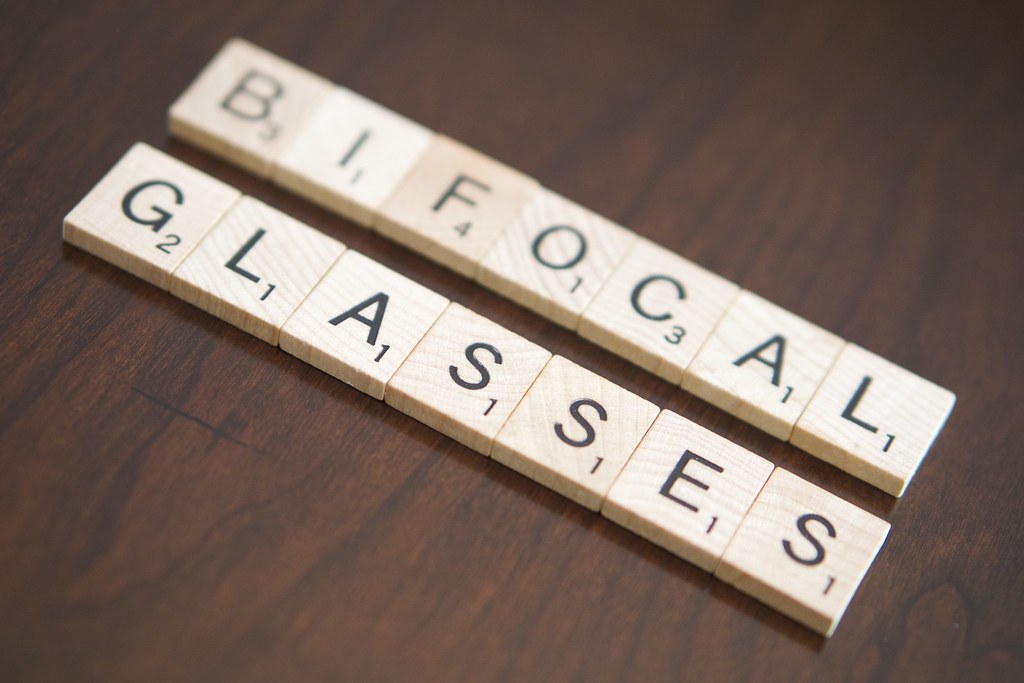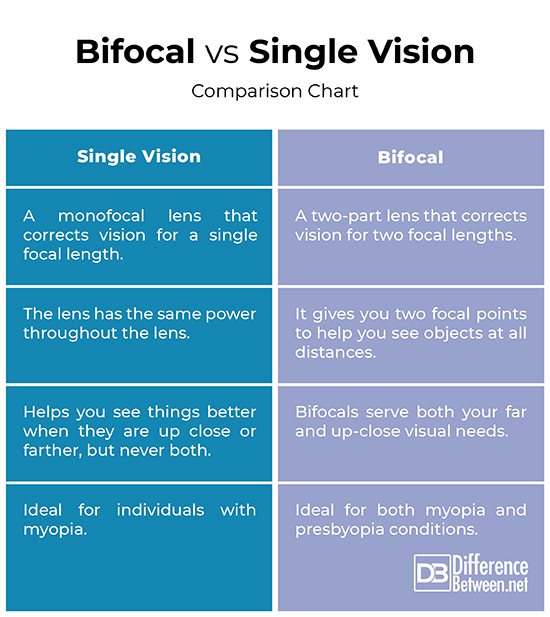Difference Between Bifocal and Single Vision
Looking for a pair of eyeglasses at the optical store? Well, when looking for the right pair for yourself, it is important to consider what your vision type is – whether single vision or bifocal. Human vision changes with aging and while you may not notice anything until 40, aging have greater potential to affect our quality of life, mainly our vision. You may have hard time seeing things clearly as you age and this is when you’re going to need glasses in order to see better. In that case, you have three options in glasses for you – single vision, bifocal, and progressive. Today, we’ll discuss about single vision and bifocal lens types, and help you understand the differences between the two.

What is Single Vision?
Single vision, as the name suggests, is a type of lens that correct vision for a single distance, meaning the lenses have the same power throughout the lens. It corrects for one single focal length whether that be far out in the distance for your daily chores or it’s up close for reading. However, if it’s your reading pair of glasses, you’ll probably not be able to see very clearly when things are at some distances. So, a single vision can be specifically for farsightedness or nearsightedness, but not for both. This means you can either use them for reading or while working on your computer or laptop for that matter, but you cannot use them outdoors.
Single vision lenses have the exact same distance between the two eyes, so they are capable for providing a much sharper, clearer vision at a specific distance that suits your needs. So, you might have to toggle the glasses on and off or remove them when looking at things at farther distances. In a nutshell, single vision lenses are specifically built for just one type of vision correction. They can help you see things better when they are up close or farther, but never both. So, there are glasses to differentiate the distance and reading.

What is Bifocal?
To overcome the shortcomings of the single vision lenses, they have invented the bifocal lens. A bifocal is exactly what it sounds like – a lens type that contains two lens powers meaning it corrects for two focal lengths, unlike a single vision. Since it has lines separating two different prescriptions, it gives you two focal points to help you see objects at all distances, whether you’re up close or far away from the object. You can just put them on while you watch TV or use your phone at the same time. You do not need to worry about removing your glasses every time you switch from one activity to another.
Bifocal lenses are basically lenses with two parts – the upper part of the lens which is for the distance vision and the lower part which attributes to the close-up vision. There’s a clearly visible line on the lens which gives you two focal points and you can actually notice an image shift when moving between viewing distances. Well, there are different variations of bifocals, ranging from blended bifocals to trifocals. So, in a nutshell, bifocals help you see things clearly when they are afar and up close, which is great for people with presbyopia – an age related condition that makes it difficult to see near objects.
Difference between Bifocal and Single Vision
Lens Type
– One of the major differences between a single vision and a bifocal lens is how they correct your sight at different distances. A single vision lens, sometimes called a “monofocal” lens is a type of lens that corrects vision for a single focal length, meaning the lenses have the same power throughout the lens. A bifocal lens, on the other hand, is a type of lens with two powers and that corrects your sight for two focal lengths, meaning they enhance your vision in two different ways.
Vision Correction
– A single vision lens is specifically built for just one type of vision correction, which means it can provide a much sharper, clearer vision at a specific distance that suits your needs. They can help you see things better when they are up close or farther, but never both. Bifocal lenses, on the other hand, are two-part lenses – the upper part of the lens is for the distance vision and the lower part attributes to the close-up vision. Unlike single vision lenses, bifocals serve both your far and up-close visual needs.
Ease of Use
– While in some cases such as individuals with myopia, single vision lenses are a better option, some conditions such as presbyopia require bifocals. You may have to toggle the single vision glasses on and off regularly or remove them when you switch from far vision to up-close vision. Bifocals, on the other hand, help you see things clearly when they are afar and up close and you don’t need to worry about removing your glasses every time you switch from reading to moving outdoors.
Bifocal vs. Single Vision: Comparison Chart

Summary
In a nutshell, single vision lenses are the type of lenses that offer a single vision correction, meaning you can see objects clearly which are farther or placed at shorter distances, but never both at the same time. They are purposely built for just one type of vision correction, which means they can provide a much sharper, clearer vision at a specific distance that suits your needs. Bifocals, on the other hand, divide the lens into two parts as in two focal points – the upper part for the far vision and the lower part for the up-close vision. So, you can keep the bifocal glasses on while you’re watching television and use your phone to look up texts at the same time.
- Difference Between Caucus and Primary - June 18, 2024
- Difference Between PPO and POS - May 30, 2024
- Difference Between RFID and NFC - May 28, 2024
Search DifferenceBetween.net :
Leave a Response
References :
[0]“Which Is Better: Progressive or Bifocal Lenses?.” foreyes.com, For Eyes, foreyes.com/blog/which-is-better-progressive-or-bifocal-lenses/. Accessed 4 May 2021.
[1]“Difference between single vision, bifocal and progressive.” LEOptique Blog, leoptique.com, leoptique.com/blog/difference-between-single-vision-bifocal-and-progressive. Accessed 4 May 2021.
[2]Efron, Nathan. Contact Lens Practice. Amsterdam, Netherlands: Elsevier, 2010. Google Books.
[3]Image credit: https://live.staticflickr.com/5092/5547021477_1510092a8e_b.jpg
[4]Image credit: https://live.staticflickr.com/7787/17516973360_1c53903483_b.jpg
